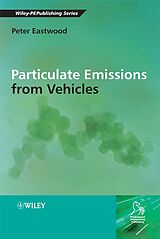Particulate Emissions from Vehicles
Format:
E-Book (pdf)
EAN:
9780470986509
Untertitel:
Englisch
Genre:
Maschinenbau, Fertigungstechnik
Autor:
Peter Eastwood
Herausgeber:
Wiley
Anzahl Seiten:
512
Erscheinungsdatum:
15.04.2008
ISBN:
978-0-470-98650-9
The public health risks posed by automotive particulate emissions
are well known. Such particles are sufficiently small to reach the
deepest regions of the lungs; and moreover act as carriers for many
potentially toxic substances. Historically, diesel engines have
been singled out in this regard, but recent research shows the need
to consider particulate emissions from gasoline engines as well.
Already implicated in more than one respiratory disease, the
strongest evidence in recent times points to particle-mediated
cardiovascular disorders (strokes and heart attacks). Accordingly,
legislation limiting particulate emissions is becoming increasingly
stringent, placing great pressure on the automotive industry to
produce cleaner vehicles - pressure only heightened by the
ever-increasing number of cars on our roads.
Particulate Emissions from Vehicles addresses a field of
increased international interest and research activity; discusses
the impact of new legislation globally on the automotive industry;
and explains new ways of measuring particle size, number and
composition that are currently under development. The expert
analysis and summary of the state-of-the-art, which encompasses the
key areas of combustion performance, measurement techniques and
toxicology, will appeal to R&D practitioners and engineers
working in the automotive industry and related mechanical fields,
as well as postgraduate students and researchers of engine
technology, air pollution and life/ environmental science. The
public health aspects will also appeal to the biomedical research
community.
Autorentext
Dr Peter Eastwood has worked as a development engineer at the Ford Motor Company, Dunton, UK, since 1998. He completed a PhD in chemical sensors at University College in Swansea in 1992, and then worked as a research engineer for Ford and subsequently Bosch in the USA before taking up his current position. He has published 1 previous title with RSP, Critical Topics in Exhaust Gas Aftertreatment.
Zusammenfassung
The public health risks posed by automotive particulate emissions are well known. Such particles are sufficiently small to reach the deepest regions of the lungs; and moreover act as carriers for many potentially toxic substances. Historically, diesel engines have been singled out in this regard, but recent research shows the need to consider particulate emissions from gasoline engines as well. Already implicated in more than one respiratory disease, the strongest evidence in recent times points to particle-mediated cardiovascular disorders (strokes and heart attacks). Accordingly, legislation limiting particulate emissions is becoming increasingly stringent, placing great pressure on the automotive industry to produce cleaner vehicles - pressure only heightened by the ever-increasing number of cars on our roads. Particulate Emissions from Vehicles addresses a field of increased international interest and research activity; discusses the impact of new legislation globally on the automotive industry; and explains new ways of measuring particle size, number and composition that are currently under development. The expert analysis and summary of the state-of-the-art, which encompasses the key areas of combustion performance, measurement techniques and toxicology, will appeal to R&D practitioners and engineers working in the automotive industry and related mechanical fields, as well as postgraduate students and researchers of engine technology, air pollution and life/ environmental science. The public health aspects will also appeal to the biomedical research community.
Inhalt
Preface. Acronyms and Abbreviations. Chapter 1. Introduction. Chapter 2. Fundamentals. 2.1 Introduction. 2.2 Properties of Aerosol Particles. 2.2.1 Diameter and Shape. 2.2.2 Size Distribution. 2.2.3 Transport and Deposition. 2.2.4 Transformation and Mutation. 2.3 Particles in the Atmosphere. 2.3.1 Character and Behaviour. 2.3.2 Aerosols in Nature. 2.3.3 Anthropogenic Aerosols. 2.3.4 Environmental Implications. 2.4 Motor Vehicle Particulate. 2.4.1 Some Typical Particles Dissected. 2.4.2 What happens within the Engine. 2.4.3 What Happens within the Exhaust. 2.4.4 Number versus Mass. 2.5 Closure. Chapter 3. Formation I: Composition. 3.1 Introduction. 3.2 Carbonaceous Fraction: I. Classical Models. 3.2.1 Empiricisms. 3.2.2 Inception. 3.2.3 Surface Growth. 3.2.4 Agglomeration. 3.2.5 Oxidation. 3.3 Carbonaceous Fraction: II. The Combusting Plume. 3.3.1 Historical Overview. 3.3.2 Premixed Burn. 3.3.3 Mixing-Controlled Burn. 3.3.4 Late Burn. 3.4 Carbonaceous Fraction: III. Wall Interactions. 3.4.1 Theoretical. 3.4.2 Experimental. 3.5 Ash Fraction. 3.5.1 Chemical Reactions. 3.5.2 Gas-to-Particle Conversion. 3.6 Organic Fraction. 3.6.1 Preparatory Chemical Reactions. 3.6.2 Chemical Reactions in the Exhaust. 3.6.3 Gas-Particle Conversion: Models. 3.6.4 Gas-Particle Conversion: Measurements . 3.6.5 White Smoke. 3.7 Sulphate Fraction. 3.7.1 Chemical Reactions. 3.7.2 Gas-to-Particle Conversion. 3.8 Closure. Chapter 4. Formation II: Location. 4.1 Introduction. 4.2 Within the Exhaust System. 4.2.1 Storage and Release. 4.2.2 Deposition within Catalysts. 4.3 Within the Exhaust Plume. 4.4 Within the Transfer Line. 4.5 Within the Dilution Tunnel. 4.6 On the Filter. 4.7 Closure. Chapter 5. Measurement. 5.1 Introduction. 5.2 Particulate Measured Conventionally. 5.2.1 Drawing a Sample of Exhaust. 5.2.2 Diluting the Exhaust. 5.2.3 Collection onto a Filter. 5.2.4 Fractionation by Gasification. 5.2.5 Fractionation by Dissolution. 5.3.6 Chemically Assaying the Organic Fraction . 5.3.7 Biologically Assaying the Organic Fraction . 5.3 Particulate Measured Individually. 5.3.1 Inertial Mobility. 5.3.2 Electrical Mobility. 5.3.3 Laser-Induced Incandescence. 5.3.4 Light Scattering. 5.4 Particulate Measured Collectively. 5.4.1 Photoacousticity. 5.4.2 Photoelectricity and Diffusion Charging. 5.4.3 Electrical Charge. 5.4.4 Flame Ionisation. 5.4.5 Mass. 5.4.6 Smoke. 5.5 Closure. Chapter 6. Characterisation. 6.1 Introduction. 6.2 Physical Characterisation. 6.2.1 Microstructure. 6.2.2 Morphology. 6.2.3 Density. 6.2.4 Surface Area. 6.2.5 Electrical Charge. 6.3 Chemical Characterisation. 6.3.1 Carbonaceous Fraction. 6.3.2 Ash Fraction. 6.3.3 Organic Fraction. 6.3.4 Sulphate Fraction. 6.4 Biological Characterisation. 6.5 Demographical Characterisation. 6.6 Closure. Chapter 7. Abatement. 7.1 Introduction. 7.2 Fuel Formulation. 7.2.1 Sulphur. 7.2.2 Hydrocarbons. 7.2.3 Oxygenates. 7.2.4 Additives. 7.2.5 Volatility, Cetane Numb...

Leider konnten wir für diesen Artikel keine Preise ermitteln ...
billigbuch.ch sucht jetzt für Sie die besten Angebote ...
Die aktuellen Verkaufspreise von 3 Onlineshops werden in Realtime abgefragt.
Sie können das gewünschte Produkt anschliessend direkt beim Anbieter Ihrer Wahl bestellen.
Loading...
Die aktuellen Verkaufspreise von 3 Onlineshops werden in Realtime abgefragt.
Sie können das gewünschte Produkt anschliessend direkt beim Anbieter Ihrer Wahl bestellen.
| # | Onlineshop | Preis CHF | Versand CHF | Total CHF | ||
|---|---|---|---|---|---|---|
| 1 | Seller | 0.00 | 0.00 | 0.00 |
